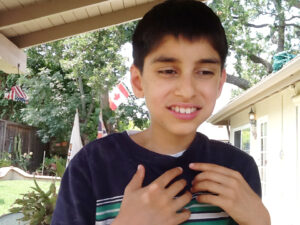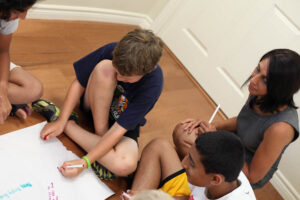Autism Spectrum Disorder
Over the past 20 years, Dr. Pure has developed an expertise in the assessment and treatment of Autism.
Autism is a spectrum disorder (ASD), meaning that there is a wide degree of variation in the way it affects children. Every child with ASD has unique abilities, symptoms, and challenges. Autism is not a single disorder, but a spectrum of closely-related disorders with a shared core of symptoms. Every child with ASD has challenges to some degree with social skills, empathy, communication, and flexible behaviour. The level of disability and the combination of symptoms varies tremendously from child to child. In many cases, two children with an ASD diagnosis may look very different when it comes to their behaviours, abilities, and personality.
ASD is a pervasive developmental condition that is a life-long disability. Pervasive means it affects all major areas of a child’s functioning including his or her:
- cognitive development
- communication
- social skills
- self-help skills
- motor skills
- leisure skills
- vocational skills
- behaviour
Some major characteristics of ASD in children can include:
- A lack of responsiveness to people (for example, acts aloof, avoids eye contact, won’t cuddle or tolerate physical contact, does not play or engage with children and adults).
- Severe language impairment (for example, mute, speech characterized by echolalia, pronoun reversal, and perseveration).
- Strong resistance to change in routine or the environment (for example, has tantrums when normal routine is altered, has many rituals or overly rigid patterns of activity, is very resistive to teaching interactions).

Additional characteristics can include:
- Extreme Inattention.
- Little or no appropriate play or interaction with toys.
- Unusual reactions to normal environmental stimulation (for example, child can show hypo or hypersensitivity to sight, smell, touch and hearing).
- Self-Stimulation (for example, rocking, twirling, spinning objects, or other rhythmic, repetitive motions).
- Behaviour can be hard to manage (for example, child cries and is inconsolable, frequent temper tantrums, engages in self-injurious behaviour, displays aggressive and destructive behaviour).
- Unusual attachment or fascination with objects.
- Uneven development and abilities.
A revision to ASD and how it is diagnosed and labeled was adopted by the Diagnostic and Statistical Manual of Mental Disorders version 5 (DSM-V), released in May 2013. The new diagnosis will encompass current diagnoses of autistic disorder, Asperger’s disorder, childhood disintegrative disorder, and PDD-NOS. Rather than categorizing these diagnoses, the DSM-V will adopt a dimensional approach to diagnosing disorders that fall underneath the autism spectrum umbrella. It is thought that individuals with ASD are best represented as a single diagnostic category because they demonstrate similar types of symptoms and are better differentiated by clinical specifiers (dimensions of severity) and associated features (known genetic disorders, epilepsy and intellectual disability). An additional change to the DSM-V includes collapsing social and communication deficits into one domain. Thus, an individual with an ASD diagnosis will be described in terms of severity of social communication symptoms, severity of fixated or restricted behaviours or interests and associated features.

The road to an autism diagnosis can be difficult and time-consuming. If you are worried that your child has autism, it’s critical to seek out a medical diagnosis. It is important to keep in mind that just because your child has a few autism-like symptoms, it does not mean he or she has ASD. ASD is diagnosed based on the presence of multiple symptoms that disrupt your child’s ability to communicate, form relationships, explore, play, and learn.
At our clinic, we can help you sort out and determine whether your child falls along the autism spectrum and start you on a process for intervention.
To aid this process, we administer various psychological assessment tools to assess for ASD. These tests include the Autism Diagnostic Interview-Revised (ADI-R) and the Autism Diagnostic Observation Schedule (ADOS, Second Edition) which are considered the “gold standards” for assessing autistic children. The ADI-R is a semi-structured parent interview that probes for symptoms of autism by evaluating a child’s current behaviour and developmental history. The ADOS is a semistructured interactive evaluation of ASD symptoms that is used to measure social and communication abilities by eliciting a number of opportunities (or “presses”) for spontaneous behaviours (for example, eye contact) in standardized context. Various other questionnaires (for example, The Childhood Autism Rating Scale) and tests of cognitive functioning are typically included in an ASD assessment battery. During the one on one assessment process with your child, Dr. Pure often requests that parents observe through a one way mirror.
Based on her experience, Dr. Pure recommends that you start early intervention with your child even if you do not have a formal diagnosis. Early intervention during the preschool years will increase your child’s chances for improving skills related to his or her developmental delays.
Dr. Pure believes that ASD is treatable with proper instruction and early intervention and children can become more responsive as they learn to understand their environment.
In our clinic, Dr. Pure advises parents about their child’s relative areas of developmental strengths and challenges. Once these areas are identified, Dr. Pure provides parents with support for day to day parenting strategies and meets with pre(school) and school teams to help develop a collaborative approach to care. For Dr. Pure, treatment programs should emphasize:
- goals that are functional
- goals that are appropriate for a child’s developmental age
- on-going assessment
- precise specification of intervention procedures
- careful monitoring of progress
- ongoing review of program implementation
Dr. Pure encourages works with the team of specialists who may be involved in diagnosing and treating your child:
- Child psychiatrists
- Speech pathologists
- Developmental paediatricians
- Paediatric neurologists
- Audiologists
- Early Interventionist
- ABA workers or therapeutic mentors
The main goals of treatment are to lessen challenges and family distress, and to increase quality of life and functional independence. Dr. Pure believes that no single treatment is best and treatment needs to be tailored to the child’s needs. Intensive, sustained special education programs and behaviour therapy early in life can help children acquire self-care, social, and job skills.
Dr. Pure follows treatment approaches that are based on applied behaviour analysis (ABA), developmental models, structured teaching, speech and language therapy, social skills therapy, and occupational therapy. She also frequently uses the social thinking curriculums and resources developed by Michelle Garcia Winner (www.socialthinking.com). Over the last decade, these resources have been highly invaluable to help support treatment at our clinic.
Treatment includes development of home based individualized programs that are executed by one on one behaviour therapists. Dr. Pure supervises these individuals and meets with them and parents once per month to ensure treatment is progressing.
The clinic also provides social skills groups for school aged children who are between 5 to 16 years old. For adolescents, Dr. Pure provides support for social and emotional development, transitioning to adulthood, and sexual education. She has a number of individuals who work as therapeutic mentors to support older teens with ASD in the community to help generalize skills.
Free Toolkit Program: Parents of children with autism spectrum disorders are challenged themselves by stress and the emotional issues that frequently arise when parenting an autistic child. The calmer and more focused you can be as a parent, the easier it is to make the best possible decisions for your child. Helpguide’s free Bring Your Life Into Balance toolkit teaches you the skills you need to remain calm and focused. Dr. Pure recommends this as a resource to parents [Authors: Melinda Smith, M.A., Jeanne Segal, Ph.D. and Ted Hutman, Ph.D (UCLA Center for Autism Research & Treatment)].

